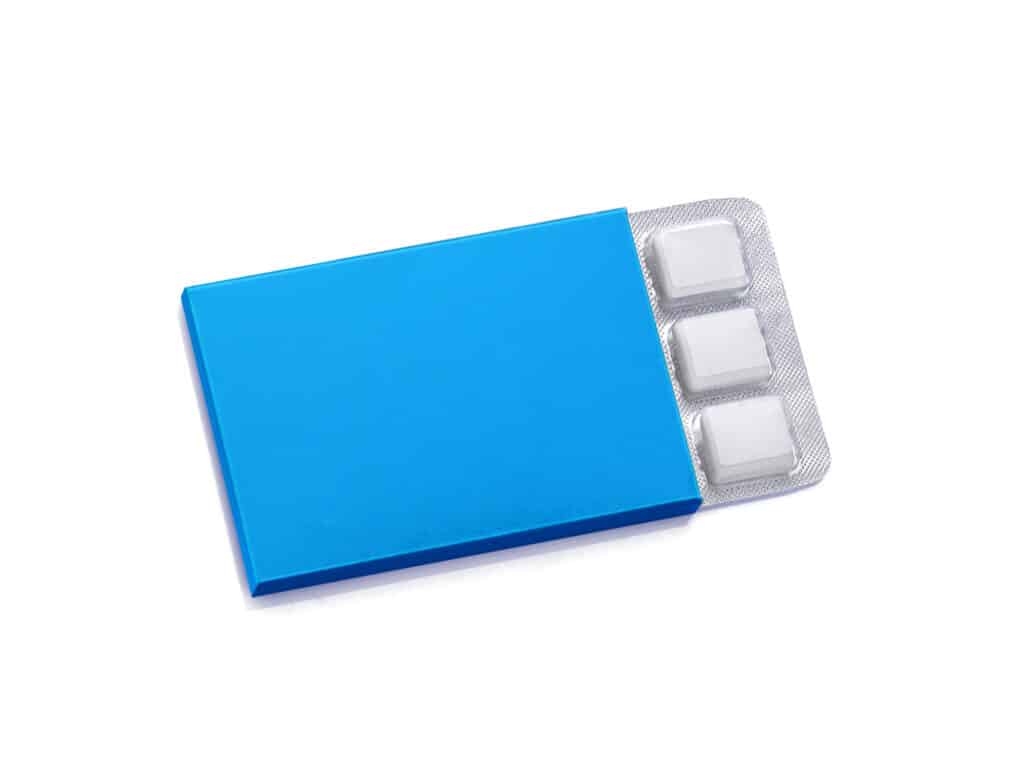It’s an easily imaginable situation: you’re walking your dog around the block, and suddenly you catch him lapping up a piece of fallen gum off the sidewalk. The act may seem innocuous, as people accidentally or intentionally swallow gum all the time without issue. However, those asking whether dogs can eat gum might be surprised to learn that the chewy substance is actually incredibly dangerous for dogs.

What should you do if suddenly you catch your dog lapping up a piece of gum off the sidewalk?
©Africa Studio/Shutterstock.com
Read on to learn the dangers of chewing gum for dogs and what to do if your canine companion accidentally eats any.

Gum is actually incredibly dangerous for dogs.
©iStock.com/graphicphoto
Can Dogs Eat Gum?
In short, dogs can absolutely not eat gum. Most gums contain xylitol, a common sweetener used to flavor the gum and make it more enjoyable to chew. Xylitol is highly toxic to dogs; as little as one piece of gum can be lethal to a ten-pound pup. While not every gum contains this ingredient, it’s common enough in most varieties to treat any chewing gum with caution around your dog. Even gums without xylitol can upset digestion and cause intestinal blockage in your pup.

Most gums contain
xylitol
, a common sweetener.
©artfotoxyz/Shutterstock.com
What is Xylitol?
Xylitol is an artificial sweetener that’s used as a low-calorie sugar substitute to flavor foods that don’t contain sugar. It’s often present in gum, candy, nut butter, and sugar-free pastries. Other common household items can also contain xylitol, including vitamins and medications, dental products, deodorant, and makeup products. Even baby wipes can contain xylitol, which helps maintain their moisture inside the packaging.

Even baby wipes can contain xylitol.,
©Emilio100/Shutterstock.com
Xylitol pet poisonings have become increasingly common, with the number of incidents more than doubling from 2015-2020. In fact, in 2020, the number of xylitol-poisoning calls was second only to calls related to chocolate poisoning!
Why is xylitol dangerous for dogs?
The typical dose of xylitol required to poison a dog is 0.05 grams (0.0018 ounce) per pound, or 0.1 grams (0.0035 ounce) per kilogram of total bodyweight. The average piece of chewing gum has between 0.22-1 gram (0.008 -0.035 ounce) of xylitol, potentially lethal for a small, ten-pound dog.

The average piece of chewing gum contains enough xylitol to potentially kill a ten-pound dog.
©iStock.com/Samohin
Xylitol affects dogs after ingestion in a condition called xylitol toxicosis. Eating xylitol triggers a massive insulin release, which incurs a rapid blood sugar drop soon after ingesting. Xylitol toxicosis can cause severe hypoglycemia and result in vomiting, depression, and even coma. Eating xylitol can also cause severe liver damage and harm healthy function.
Typically, signs of xylitol poisoning develop in about 30-60 minutes and include:
- Vomiting
- Fatigue
- Depression
- Hypokalemia (low potassium levels)
- Seizure
- Loss of consciousness
Other Dangers of Giving Your Dog Gum
Chewing gum can also block your dog’s gastrointestinal tract. The sticky, chewy texture of gum is difficult for your pup to digest correctly, causing upset stomachs, vomiting, loss of appetite, and diarrhea.
As with humans, chewing gum also represents a choking hazard. It’s too easy for a lump of gum to get lodged in your pup’s esophagus and prevent breathing. Gum with sugar (free of xylitol) can also raise your dog’s blood sugar, increasing blood glucose and leading to long-term health issues.
What to Do if Your Dog Accidentally Eats Gum
If your dog accidentally eats gum that contains xylitol, immediately call your vet or the local pet poison hotline. Do not induce vomiting or give anything orally to your pet unless your veterinarian explicitly directs you to, as vomiting can worsen hypoglycemia symptoms.
Taking your dog in for treatment as fast as possible is vital. The prognosis for hypoglycemia is usually good if addressed immediately. However, if not immediately addressed by veterinary intervention, xylitol consumption can be fatal. There’s no antidote for xylitol poisoning.

If your dog accidentally eats gum that contains xylitol, immediately call your vet or the local pet poison hotline.
©didesign021/Shutterstock.com
After treatment, your vet will monitor your dog for at least 12 hours to check for improving blood sugar and liver function signs. Your dog may need one or two days on an IV glucose solution to restore his blood sugar to healthy levels.
How to Prevent Your Dog from Eating Gum
Dogs tend to go after any sweet treat they can get their paws on, so prevention is essential regarding chewing gum. Remove any xylitol-containing gum or candy from your dog’s reach to keep him away from potential harm. You also need to watch out for dogs sneaking any chewing gum from a purse, trashcan, or off the ground during walks.

Remove any xylitol-containing gum or candy from your dogs to keep them away from potential harm.
©iStock.com/retouchman
Prevention is the best medicine: as you never know if the gum that your dog is eating contains xylitol, it’s best to err on the side of caution.
Going forward, remember that dogs cannot eat gum, and every effort should be main to keep your pup away from the chewy, potentially lethal treats. If your dog finds a rogue piece, immediately contact your vet and obtain treatment as quickly as possible.
Up Next:
- Can Dogs Eat Artificial Sweeteners?
- Can Dogs Eat Gummy Bears?
- Can Dogs Eat Peppermint?
- Can Dogs Eat Sugar?
The photo featured at the top of this post is © Annette Shaff/Shutterstock.com
Ready to discover the top 10 cutest dog breeds in the entire world?
How about the fastest dogs, the largest dogs and those that are -- quite frankly -- just the kindest dogs on the planet? Each day, AZ Animals sends out lists just like this to our thousands of email subscribers. And the best part? It's FREE. Join today by entering your email below.
Sources
- a-z-animals.com, Available here: https://a-z-animals.com/pets/dogs/
- aka.org, Available here: https://www.akc.org/expert-advice/health/dog-accidentally-eats-gum-can-gum-make-my-dog-sick/
- a-z-animals.cm, Available here: https://a-z-animals.com/blog/can-dogs-eat-artificial-sweeteners-what-are-the-risks/
- aaha.org, Available here: https://www.aaha.org/publications/newstat/articles/2021-03/stealth-xylitol-poisonings-on-the-rise/?fbclid=IwAR207e0ad_7KNtzbux5JdRezKUyew6Ji1-YUCvjx0CUCwRqclLDsrpBvLoE
- petpoisonhelpline.com, Available here: https://www.petpoisonhelpline.com/toxin-tails/xylitol-poisonings-doubled/
- a-z-animals.com, Available here: https://a-z-animals.com/blog/can-dogs-safely-eat-chocolate-the-myths-and-true-dangers/
- merckvetmanual.com, Available here: https://www.merckvetmanual.com/toxicology/herbicide-poisoning/herbicide-poisoning-in-animals
Thank you for reading! Have some feedback for us? Contact the AZ Animals editorial team.






